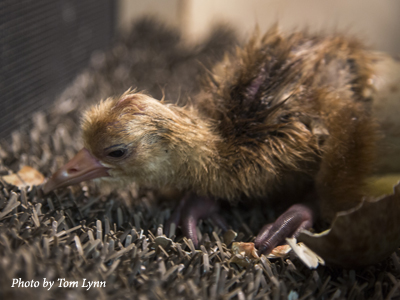Contact: Anne Sayers, Director of Marketing & Communications, 608-356-9462 x118
 The International Crane Foundation Announces the First Hatch of the Season at Baraboo Headquarters
The International Crane Foundation Announces the First Hatch of the Season at Baraboo Headquarters
Baraboo – The International Crane Foundation has announced the first Whooping Crane hatch of the season at its headquarters in Baraboo, Wisconsin. The Whooping Crane hatched via the International Crane Foundation’s captive breeding program, a program dedicated to increasing the number of Endangered Whooping Cranes in the wild. The hatch marks the beginning of a critical breeding season for the International Crane Foundation, which is slated to raise chicks for release in Louisiana and Wisconsin.
“The chick is definitely adorable, but it’s a lot more than that. As one of just several hundred Whooping Cranes in existence, it has a critical role to play in safeguarding its species. But we’ll be there every step of the way to increase this chick’s – and the Whooping Crane species’ – chances for success,” remarked Kim Smith, Vice President of Headquarter Operations for the International Crane Foundation.
In the 1940s, there were fewer than 20 Whooping Cranes left in the wild. With concerted human effort, their numbers have climbed to about 450. While today’s number is encouraging, it isn’t enough to guarantee the long-term survival of the species, especially given the number of threats they face, which include water shortages, power line collisions, habitat destruction, predation, and shootings.
The International Crane Foundation plays a leading role in the recovery of Whooping Cranes, from captive breeding and release programs, habitat protection, threat reduction along their flyways, education, and outreach. This season, the International Crane Foundation will raise some chicks by staff in crane costumes – the costumes hide the human form and limit the chicks bonding with people – for release into Louisiana’s non-migratory population that currently numbers about 40. Other chicks will be “parent-reared” a method where captive adult Whooping Crane pairs raise chicks without the use of costumed staff. Prior to the fall migration, the chicks will be released in Wisconsin near wild Whooping Crane pairs with the goal of encouraging adult pairs to “adopt” the young birds and teach them the migratory route to the southeast United States.
“The long-term survival of Whooping Cranes won’t just happen. Behind each successful wild bird are countless individuals who are working every day to create a future where Whooping Cranes are safe and successfully reproducing in the wild,” concluded Smith.
Whooping Cranes are the tallest bird in North America, standing up to 5 feet tall. It is one of only two crane species found in North America. To date, there have been 25 Whooping Crane eggs laid this year at the International Crane Foundation’s headquarters. For the latest egg statistics, click here to follow the Egg Score Card.
###
The International Crane Foundation works worldwide to conserve cranes and the ecosystems, watersheds,
and flyways on which they depend.
